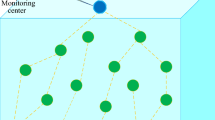Abstract
The problem of localization in under water sensor nodes has led to proposal of many techniques over the past few decades that depend primarily on Time of Arrival and Time Difference of Arrival. While these techniques are intuitively very appealing and easy to deploy, accurate node localization in dynamic under water environment has remained elusive. Sensor nodes deployed underwater tend to move from their original positions due to water currents and hence their exact positions at a given moment of time are not known with precision. Due to inherent drawbacks of radio signal propagation in underwater environment, localization of sensor nodes depends on acoustic signals. In this paper, we propose a Doppler shift based localization followed by a genetic algorithm based optimization technique that improves accuracy in localizing unknown nodes in underwater sensor networks. The proposed technique envisages sink nodes playing a pivotal role in taking over a bulk of the computational load on account of being comparatively more accessible and serviceable as compared to any other nodes in the network that are deployed underwater. The algorithm relies on observed frequency shifts (Doppler shift) of sound waves compared to actual, that happen when source and observer are mobile as they do in a marine environment. While Doppler shift determines the approximate location of an unknown sensor node, genetic algorithm minimizes the error in localization. Our proposed methodology has much lower localization error as compared to existing protocols.













Similar content being viewed by others
References
Qi Y, Cheng P, Bai J, Chen J (2016) Energy-efficient target tracking by mobile sensors with limited sensing range. IEEE Trans Ind Electron 63(11):6949–6961. https://doi.org/10.1109/TIE.2016.2584000
He S, Chen J, Li X, Shen XS, Sun Y (2014) Mobility and intruder prior information improving the barrier coverage of sparse sensor networks. IEEE Trans Mobile Comput 13(6):1268–1282. https://doi.org/10.1109/TMC.2013.129
Yan J, Li X, Luo X, Guan X (2017) Virtuallattice based intrusion detection algorithm over actuator-assisted underwater wireless sensor networks. Sensors 17(5):1168–1185. https://doi.org/10.3390/s17051168
Erol-Kantarci M, Mouftah HT, Oktug S (2011) A survey of architectures and localization techniques for underwater acoustic sensor networks. IEEE Commun Surv Tutor 13(3):487–502. https://doi.org/10.1109/SURV.2011.020211.00035
Chandrasekhar V, Choo YS (2006) Localization in underwater sensor networks survey and challenges. In: WUWNet 2006–proceedings of the first ACM international workshop on underwater networks, pp 33–40. https://doi.org/10.1145/1161039.1161047
Bian T, Venkatesan B, Li C (2009) Design and evaluation of a new localization scheme for underwater acoustic sensor networks. In: Proceedings of 28th IEEE conference on global telecommunications, Honolulu, HI, USA, pp 142–149. https://doi.org/10.1109/GLOCOM.2009.5425366
Ma Y, Hu Y (2009) ML source localization theory in an underwater wireless sensor array network. In: Proceedings of the 5th international conference on wireless communications, networking and mobile computing, Beijing, China, pp 1–4. https://doi.org/10.1109/WICOM.2009.5303840
Bian T, Venkatesan B, Li C (2010) An improved localization method using error probability distribution for underwater sensor networks. In: Proceedings of 2010 IEEE international conference on communications (ICC), Cape Town, South Africa, pp 1–6. https://doi.org/10.1109/ICC.2010.5501953
Liu B, Chen H, Zhong Z, Vincent Poor H (2010) Asymmetrical round trip based synchronization-free localization inlarge-scale underwater sensor networks. IEEE Trans Wirel Commun 9(11):3532–3542. https://doi.org/10.1109/TWC.2010.090210.100146
Cheng X, Thaeler A, Xue G, Chen D (2004) TPS: a time-based positioning scheme for outdoor wireless sensor networks. In: INFOCOM 2004. Twenty-third annual joint conference of the IEEE computer and communications societies, Hong Kong, China, pp 2685–2696. https://doi.org/10.1109/INFCOM.2004.1354687
Cheng X, Shu H, Liang Q (2007) A range-difference based self-positioning scheme for underwater acoustic sensor networks. In: Proceedings of international conference on wireless algorithms, systems and applications (WASA), pp 38–43. https://doi.org/10.1109/WASA.2007.40
Cheng X, Shu H, Liang Q, Du DH (2008) Silent positioning in underwater acoustic sensor networks. IEEE Trans Veh Technol 57:1756–1766. https://doi.org/10.1109/TVT.2007.912142
Kussat NH, Chadwell CD, Zimmerman R (2005) Absolute positioning of an autonomous underwater vehicle using GPS and acoustic measurements. IEEE J Ocean Eng 30(1):153–164. https://doi.org/10.1109/JOE.2004.835249
Mirza D, Schurgers C (2008) Motion-aware self-localization for underwater networks. In: Proceedings of the 3rd ACM international workshop on underwater networks, San Francisco, CA, USA, pp 51–58. https://doi.org/10.1145/1410107.1410117
Guo Y, Liu Y (2013) Localization for anchor-free underwater sensor networks. Comput Electr Eng 39(6):1812–1821. https://doi.org/10.1016/j.compeleceng.2013.02.001
Yan J, Zhang X, Luo X, Wang Y, Chen C, Guan X (2018) Asynchronous localization with mobility prediction for underwater acoustic sensor networks. IEEE Trans Veh Technol 67(3):2543–2556. https://doi.org/10.1109/TVT.2017.2764265
Nagireddy V, Parwekar P, Mishra TK (2018) Velocity adaptation based PSO for localization in wireless sensor networks. Evolut Intell. https://doi.org/10.1007/s12065-018-0170-4
Gong Z, Li C, Jiang F (2018) AUV-aided joint localization and time synchronization for underwater acoustic sensor networks. IEEE Signal Process Lett 25(4):477–481. https://doi.org/10.1109/LSP.2018.2799699
Zhou Z, Cui JH, Zhou S (2010) Efficient localization for large-scale underwater sensor networks. Ad Hoc Netw 8(3):267–279. https://doi.org/10.1016/j.adhoc.2009.08.005
Han Y, Zhang J, Sun D (2018) Error control and adjustment method for underwater wireless sensor network localization. Appl Acoust 130:293–299. https://doi.org/10.1016/j.apacoust.2017.08.007
Liu L, Wang R, Wu J (2018) On the adaptive data forwarding in opportunistic underwater sensor networks using GPS-free mobile nodes. J Parallel Distrib Comput 122:131–144. https://doi.org/10.1016/j.jpdc.2018.08.004
Heidemann J, Li Y, Syed A, Wills J, Ye W (2005) Underwater sensor networking: research challenges and potential applications. In: USCISI Technical Report, IEEE: Piscataway, NJ, USA
Arora S, Singh S (2017) Node localization in wireless sensor networks using butterfly optimization algorithm. Arab J Sci Eng 42(8):3325–3335. https://doi.org/10.1007/s13369-017-2471-9
Harikrishnan R, Jawahar Senthil Kumar V, Sridevi Ponmalar P (2016) Firefly algorithm approach for localization in wireless sensor networks. Smart Innov Syst Technol 44:209–214. https://doi.org/10.1007/978-81-322-2529-4-21
Peng B, Li L (2015) An improved localization algorithm based on genetic algorithm in wireless sensor networks. Cognit Neurodyn 9(2):249–256. https://doi.org/10.1007/s11571-014-9324-y
Author information
Authors and Affiliations
Corresponding author
Additional information
Publisher's Note
Springer Nature remains neutral with regard to jurisdictional claims in published maps and institutional affiliations.
Rights and permissions
About this article
Cite this article
Datta, A., Dasgupta, M. On accurate localization of sensor nodes in underwater sensor networks: a Doppler shift and modified genetic algorithm based localization technique. Evol. Intel. 14, 119–131 (2021). https://doi.org/10.1007/s12065-019-00343-1
Received:
Revised:
Accepted:
Published:
Issue Date:
DOI: https://doi.org/10.1007/s12065-019-00343-1




